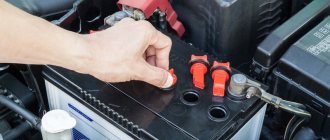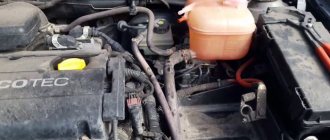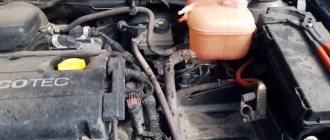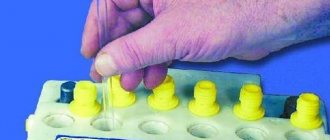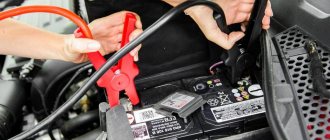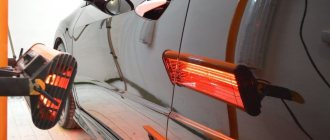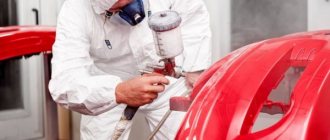Purpose of distilled water
Distilled water is an important component in the liquid of a car battery, ensures its full functionality, maintains the desired density of the electrolyte, which contains 65%. And the percentage of sulfuric acid is only 35%.
Sulfuric acid is a fairly highly concentrated chemical compound that, in its pure form, poses a danger to the battery. To reduce its concentration, purified water is needed. The ratio Н2О/H2SO4 = 65/35 ensures the accumulation of electrical energy at the time of charging the battery, which is subsequently used to start and move the vehicle.
Distilled water (DV) is ordinary water purified from organic compounds (waste products of plants and animals, bacteria, viruses) and inorganic impurities (salts, mineral additives, other substances). It consists of two chemical elements: hydrogen (H) and oxygen (O).
Before you find out how much distilled water to add to the battery, it is important to understand that ordinary water is not suitable for such a procedure. It contains a large number of different impurities (salts, chlorine, lime and others), which contribute to the rapid failure of the car battery. You cannot pour boiled water into the battery, since ordinary boiling does not distill (purify) the liquid in full.
Why is distilled water added to the car battery and what is it?
A certain amount of distilled water in the liquid inside the battery is a necessary component. It is this that ensures full operation of the battery, maintaining the optimal density of its electrolyte. It consists of 65% sulfuric acid, and the percentage of sulfuric acid in it should be much less - only 35%.
Since sulfuric acid is a useful, but very dangerous and highly concentrated chemical compound, purified water acts as a lowering level of its concentration to a useful one that will not harm the battery.
Moreover, the 65:35 ratio level in the battery precisely ensures the process of accumulating electrical energy inside it during the charging process. This energy will then be consumed when starting the engine and driving the car.
What is distilled water? This is a pure liquid that has been distilled, that is, purified. It consists of three atoms, two of which are hydrogen and the other oxygen, and does not contain any additional impurities, which may consist of salts and other substances .
Before you find out the answer to the question of how much distilled water to add to the battery, it is important to understand that you cannot pour ordinary water into the battery . A large level of impurities in the form of chlorine, salts and even lime, which will settle on the lead plates of the battery, will quickly lead to sulfation and failure.
Boiled water cannot be poured into the battery either : simple boiling without the use of certain technologies does not distill its composition properly. Simply taking and boiling water does not mean purifying it completely.
This is interesting: How to restore a laptop battery yourself
There is an opinion that distilled water can be prepared at home. But, since this process is quite labor-intensive and energy-consuming, it is best to purchase it in specialized stores, paying attention to the shelf life, which, on average, is about a year.
Why is no electrolyte used?
During the operation of the battery, especially in the summer, the battery heats up, as a result of which the jars may boil. The DW evaporates at this moment. Acid is a non-volatile liquid; accordingly, it remains and the concentration of water decreases. The density of the mixture sometimes increases to 1.4 g/cm3. Therefore, in order to bring the electrolyte to normal density, it is necessary to add DV.
If you pour electrolyte, the density will decrease, but not enough.
It is important to remember about salt precipitation and destruction of the plates. Therefore, in order to reduce the density of the liquid to the established norm, only DV is added. This rule must always be remembered!
It is also worth remembering that water is added only to batteries of the type being serviced, which are characterized by maximum evaporation. Maintenance-free batteries are equipped with a molded sealed case; the evaporated liquid does not come out, it precipitates inside the can. In this case, a closed cycle occurs; there is no need to add water.
We recommend: Comparison of batteries from the top car batteries
When is battery refilling required?
Most experts believe that car batteries do not require maintenance. Accordingly, adding water to it is irrelevant, but provided that the battery is used under normal conditions. It is imperative to check the fluid level for motorists who travel long distances in their own cars. In this case, the probability of converting the liquid into a vapor state is greatest. And also the active process of water evaporation is carried out in the event of failure of the relay regulator.
Main indicators of failure of the relay regulator:
- during the operation of the vehicle, the battery becomes very hot;
- drops of electrolyte are observed on the battery body;
- Strong steam comes out of the filler necks.
It is necessary to take into account the design of the battery. In serviced models, much greater evaporation of H2O occurs. Therefore, it is for them that it is worth knowing how much water to add to the battery. In maintenance-free models, evaporation of liquid into the environment is prevented by a sealed cast housing. Such batteries do not require additional maintenance.
Checking the electrolyte level
The presence of electrolyte is checked exclusively in serviced batteries.
They are most often equipped with a transparent body, so inspection is carried out visually. For this purpose, special marks are made on the surface corresponding to a certain volume of liquid. Serviceable batteries with an opaque casing are also available. To determine to what level to add water to the battery in this case, the vehicle owner will need a special transparent tube with a diameter of 0.5 cm.
Fluid level check sequence:
- The battery cover is unscrewed;
- the transparent tube is lowered into the liquid, and it should rest against the bottom of the jar;
- its outer hole is clamped tightly with a finger;
- it is then removed from the battery to determine the electrolyte level.
Such a tube has minimum and maximum divisions. Accordingly, if the accumulated liquid is within these limits, the volume of electrolyte is normal. If the fluid is below the minimum, you need to add DV.
How to make distilled water at home
Some car enthusiasts prefer not to buy distilled water, but to make it themselves. Usually these are people of the older generation, accustomed to times of scarcity and who do not want to change. But residents of remote villages where there are no shops have to adapt in a similar way.
Let us immediately note that it is impossible to obtain high-quality distilled water at home. To do this, you need a distiller, the cost of which is not comparable to the price of a bottle of water. As an alternative, you can use a moonshine still if you remove the coil from it. But the yield of distilled water with this method is insignificant - about a glass in 3-4 hours.
Distilled water has the formula H2O, that is, it does not contain foreign impurities. No matter how hard you try, it is almost impossible to get a similar result at home - a small part of the metal salts will remain in the water.
If you urgently need to top up the battery with water, put it in a plastic bottle and put it in the refrigerator for 2-3 hours. Then drain the unfrozen water into the sink, and melt the ice and use it to pour into jars. In this case, the damage to the battery will be minimal.
You can collect rainwater in a plastic container, then carefully filter it and use it for its intended purpose.
It is important that the water does not come into contact with metals. For example, the one that drips from tin roofs is not suitable for filling the battery.
How much water should be added
With modern batteries it is easier to figure out how much DV to add to the system. Their body is often made of transparent plastic, on which the liquid volume scale is broken. You just need to visually monitor its level in the system. It should not be less or more than the permissible norm.
We recommend: How to properly remove the battery from a car
Recommendations on how to add distilled water to a battery of a different design are as follows:
- Some battery models have a plastic (metal) “tongue” slightly below the neck of the can. It is necessary to fill the liquid 0.5 cm above it.
- If there are no marks in the jar, add water 1.5 cm above the lead plates.
- If it is impossible to visually determine the presence of electrolyte in the battery, then it is recommended to use a specialized glass tube with a scale.
It is important to correctly top up the electrolyte so that the density of the electrolyte meets the established standards. At higher concentrations, hydrochloric acid will destroy lead plates.
If it is deficient, you can defrost a car battery at significant sub-zero temperatures.
Why do they pour water into the battery? Reasons
Distilled water in the battery is a component necessary for the performance of the electrolyte and battery. It is standard that the electrolyte contains 65% distillate and only 35% sulfuric acid. This ratio of water and acid allows you to maintain optimal electrolyte density.
Sulfuric acid is a very dangerous and aggressive compound. It cannot be used in its pure form, as this will quickly destroy the battery. After adding water to the battery, the acid concentration in the electrolyte decreases and allows it to perform its functions through the current wire without damaging the plates.
Important! If you need to fill the battery with liquid to the required level, then water is chosen for this. You should not pour pure acid into the battery, even if this is required to increase the density. For such a case, there is a correction electrolyte solution.
But unlike acid, water can evaporate from the battery during battery use. This in turn increases the density of the conductive fluid, which can negatively affect the plates. This is why it is necessary to add distilled water to the battery. This keeps it running.
Also, water boils away if you recharge the battery. That is why it is worth using the battery according to all the rules. This will help the device operate normally.
How much distilled water should I add to the battery?
In modern batteries, it is quite easy to understand exactly how much distilled water needs to be added to the battery. There are varieties of batteries with a transparent case on which marks are applied. If the battery does not have a transparent case, it must have a metal or plastic tongue located below the neck. In such a battery, the electrolyte level should be 0.5 cm above this mark.
If there are no marks on the battery indicating the required electrolyte level. In this case, it is necessary to add water so that the total volume of liquid covers the plates by 1.5-2 cm.
You can determine the level using a glass tube. It is necessary to lower it to the lead plate and clamp the end from the outside with your finger. Then take it out. The remaining liquid in the tube will be the level above the plates. The tube is required to be filled to 2 cm.
Important! It is worth carefully monitoring the fluid level in the battery, as well as the density of the electrolyte. A lack of distillate will have a bad effect on the condition of the plates. And its excess undermines the battery's performance. Also, in cold weather, highly diluted electrolyte can freeze.
How to add fluid correctly
If the density of the electrolyte in a car battery has increased or the battery does not provide the required voltage, then the reason is evaporation of the active substance. According to the norm, the electrolyte consists of: H2SO4 (sulfuric acid) - 35%; H2O - 65%.
Instructions for adding fluid to the battery:
- The upper surface of the battery is cleaned of dirt and thoroughly wiped, especially near the plugs.
- While charging the battery, sulfuric acid may have splashed out. Therefore, to neutralize it, the neck area must be wiped with a rag soaked in a soda solution.
- Now you need to carefully unscrew the plugs. It is recommended to wear gloves to protect your hands from the electrolyte.
- Using a medical syringe, DV is drawn up and poured into jars where the liquid level has dropped.
- The plugs are screwed in.
- After 2 hours, it is necessary to check compliance with the electrolyte density standards using a special device - a hydrometer. If the indicators are normal, the battery can be charged.
Add liquid only on a horizontal surface, otherwise the level will show the wrong volume. It is also worth considering the fact that the density of the electrolyte differs in different climatic conditions. For example, in Russia:
- in the south of the country - 1.25 g/cm3;
- in the central regions - 1.27 g/cm3;
- in the northern territories - 1.29 g/cm3.
We recommend: Tudor Technica battery: technology of choice
To accurately measure the density of a liquid, the hydrometer must be strictly in a free state, in a vertical position and not in contact with the walls of the container. Having carefully lowered the hydrometer into the liquid, you need to wait until it completely stops oscillating, then take readings on the scale at the point of its intersection with the surface of the electrolyte. This is the density of the liquid.
Obtaining distillate at home
There are motorists who do not go to the store for DV.
They produce it themselves at home. This is mainly the older generation, who lived through times of shortage, and people living in settlements remote from the city, where many products simply do not arrive. If you want to prepare DV yourself, you should understand that it will not be of high quality, since for this you need to have special expensive equipment - a distiller. But as an alternative, a regular moonshine still without a coil is suitable. The productivity of the DV when using this option will be approximately 1 glass in 3-4 hours.
The formula of distilled water is H2O. A high-quality liquid should not contain foreign impurities. It is impossible to achieve such a result under domestic conditions; a small content of metal salts will still remain.
Recommendations:
- If you urgently need to add water to the battery, you can take it from the tap into a plastic bottle and put it in the freezer for 2-3 hours. You should only use ice that has been melted beforehand. Unfrozen water is drained into the sink. The DV obtained in this way will cause minimal damage to the battery.
- Another way is to collect rainwater in a plastic container, carefully filter it, and then use it for its intended purpose.
Important! The collected water for the battery should not come into contact with iron objects. For example, water running off the metal roof of a house is not suitable for this purpose.
How much distilled water should be added to the battery and how to do it correctly
If your battery is maintenance-free, you do not need to carry out any manipulations with liquids. A serviced lead-acid system will need to periodically add water. In order to determine how much liquid to add, you need to remove the top caps from the battery cans and check the density of the battery and the electrolyte level in each of the containers.
The amount of water that should be poured into the battery may vary, depending on its capacity and the operating conditions of the battery. It is worth thinking about how to add distilled water to the battery at any time, because the liquid level may become lower at the most inopportune moment. To do this, it doesn’t hurt to always have a suitable container for water in your car, for example, a liter bottle, and you can always add water. Do not allow the battery plates to become exposed - they will quickly crumble as a result of heating.
The algorithm for how to properly fill a battery with water at home is simple:
- Disconnect the battery from the vehicle's on-board network . Take it out of the car.
- Make sure that the surface on which it will be placed is level .
- Clean the battery from dust and dirt . You can do this with a soda solution.
- For maximum accuracy, use a disposable syringe . And for your own safety , wear technical gloves that you usually use for gardening or cleaning.
- Remove the battery caps to access the jars.
- Check the liquid level inside each can . Remember that normally the electrolyte should cover the battery plates by 1-1.5 cm.
- If the coating level of the plates is less, add 5 to 10 ml of distilled water to each battery compartment .
- If it turns out that the syringe has “overfilled”, simply suck out the excess liquid with a small rubber bulb to the desired level .
Below are some more tips regarding battery operation. This information will be useful if you do not know how to add water to the battery correctly:
- You cannot add fluid to the battery if you have just turned off the internal combustion engine . Let the battery “stand” for 7-8 hours (preferably at home). Only then open the battery.
- Also, after the battery is filled with distilled water, you cannot immediately start the engine .
- The waiting time after filling is until the next morning . Otherwise, the battery may immediately boil and the plates may crumble.
- Remember that the “country” version of the room used for filling the battery can only be used in the warm season . If the room is not heated, you should not perform such actions with the battery.
- It is important to know that using distilled water will not return the battery to its previous capacity , but will improve its performance for a certain period.
- Before starting the engine, always check the electrolyte level in the battery , keeping in mind the quantitative indicators.
This is interesting: How to calibrate gadgets on Android and more
